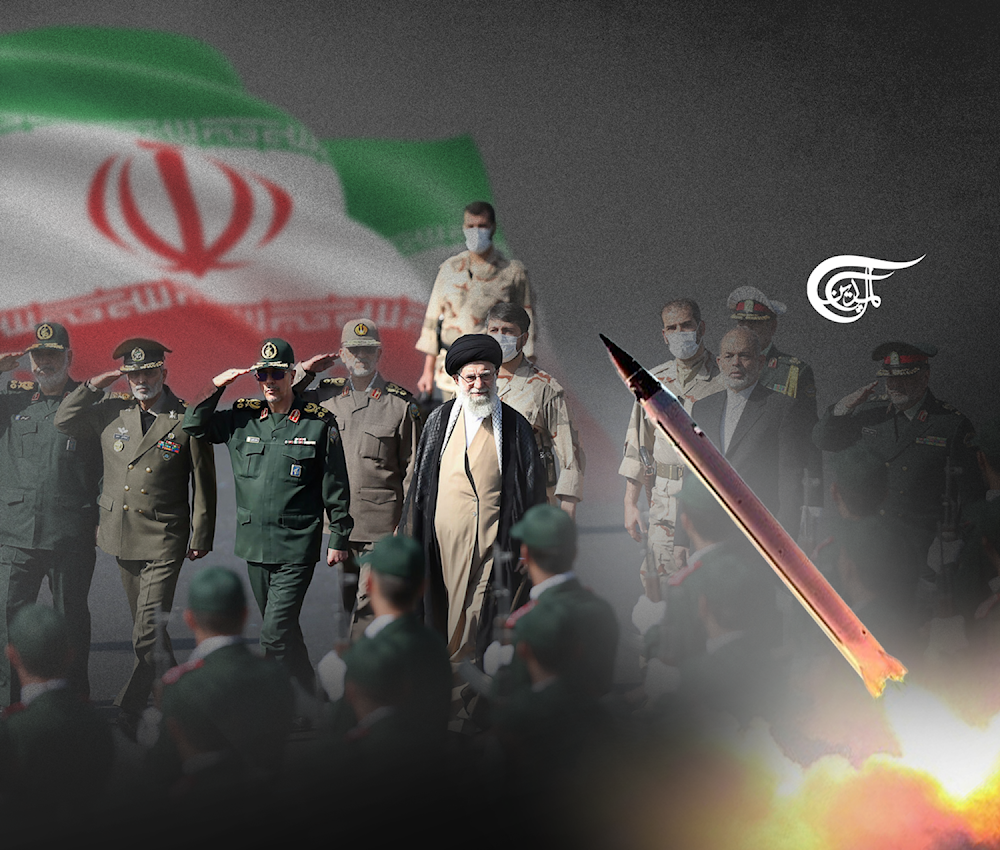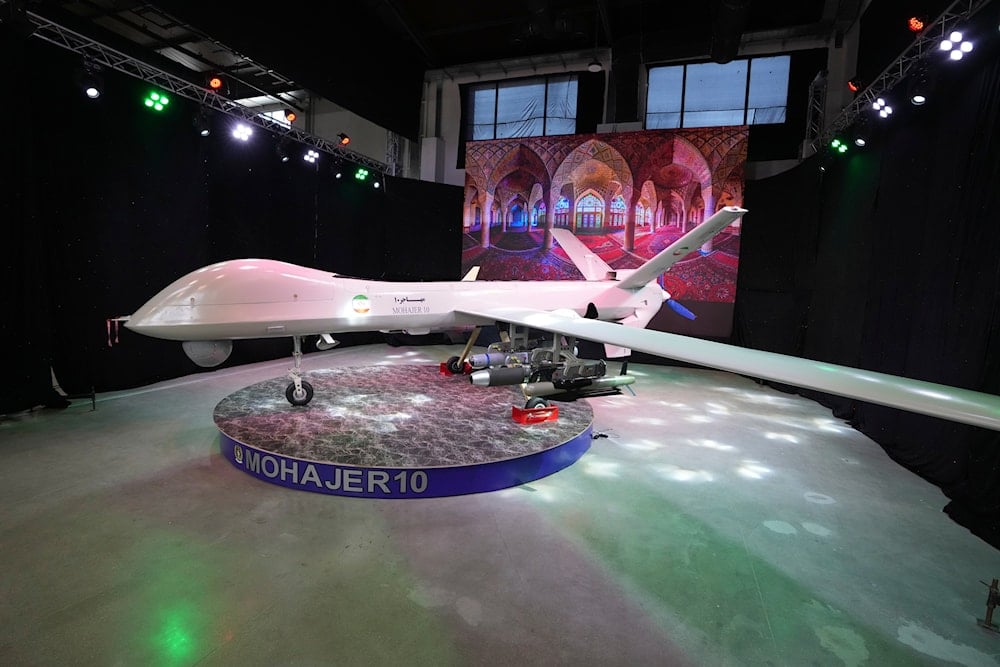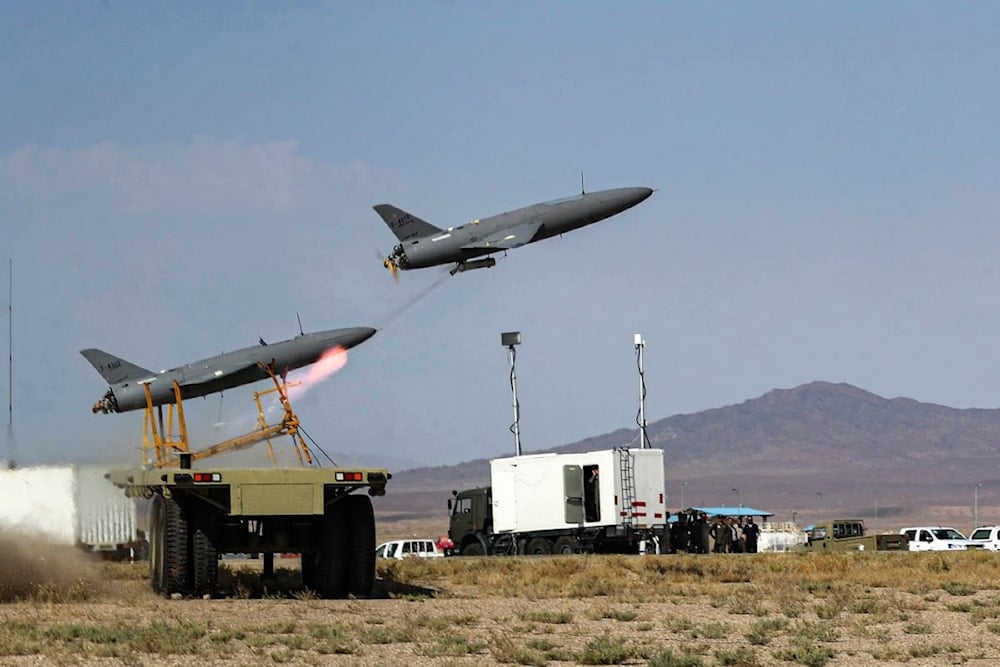Iran's military, world leading missile-drone arsenal: Overview
Find out more about Iran's military capabilities and its command chain, as the world anticipates its response to "Israel".
-

The Iranian military industry has made major advancements spurred by the Islamic Revolution's struggle toward regional independence. (Al Mayadeen English; Illustrated by Mahdi Rtail)
Iran's anticipated response to the malicious Israeli attack on the country's embassy has prompted global media to analyze and discuss Tehran's military capabilities.
Among global outlets are Western and Israeli outlets, which have put extensive and multiple reports, encompassing opinion pieces, analysis reports, and by-the-hour updates on the situation. The latest report published by The New York Times discussed Iran's military capabilities and the weapons that make its armed forces exceptional.
How many military personnel does Iran have?
Citing the International Institute for Strategic Studies, NYT said that the Iranian Armed Forces are among the largest in West Asia, having at least 580,000 active-duty personnel and about 200,000 trained reservists, which are distributed among traditional forces and the Iranian Islamic Revolution Guard Corps (IRGC).
It is worth noting that both the military and the IRGC have separate and active ground, air, naval, and missile forces with the IRGC's capabilities fitted for different tasks, such as defending Iran's borders, engaging in offensive missions, and supporting regional allies under the umbrella of the Axis of Resistance.
Who makes the high-level decisions in Iran?
The General Staff of the Armed Forces is at the top of the Iranian military's hierarchy and is headed by the IRGC's Major General Mohammad Bagheri, who was appointed by the Iranian leader Sayyed Ali Khamenei to the position. On that note, it is worth noting that Sayyed Khamenei, being elected to the highest decision-making role in the country, has the final say on strategic military decisions in the country.
-

Sayyed Ali Khamenei leads the Eid al-Fitr prayer marking the end of the Muslim holy month of Ramadan, in Tehran, Iran, ahead of Iranian officials and high-ranking military personnel, on April 10, 2024. (AP)
Iran's allies and the Axis of Resistance
Prominently, the IRGC's Quds Force has set itself to become one of Iran's most developed and experienced units, tasked with supporting regional allies and liberation movements across the region. The Quds Forces' cadres have deep-rooted relations with the Islamic Resistance in Iraq and the Islamic Resistance in Lebanon, as well as other prominent factions in West Asia, working diligently to support and advance these movements.
This, in turn, has created a network among the factions, including the Palestinian Resistance factions, Hezbollah, the Islamic Resistance in Iraq, the Yemeni Armed Forces, and the Resistance factions in Syria, which has allowed the allies to coordinate complementary and individual actions.
Aided with expertise and military know-how from Iranian officers and advisors, members of the Axis of Resistance have greatly enhanced their capabilities and weapons production systems to aid the strategic struggle for anti-hegemonic independence and liberation from Western and Israeli plots.
"The level of support and types of systems Iran has provided for nonstate actors (members of the Axis of Resistance) is really unprecedented in terms of drones, ballistic missiles, and cruise missiles," said Fabian Hinz, an expert on Iran’s military at the International Institute for Strategic Studies in Berlin.
Read more: Red Sea rising: Exposing the West's diminishing naval power
Iran's homegrown weapons, missiles, drones
Since the victory of the Islamic Revolution in Iran, the nation, previously considered to be part of the Western powers' sphere of influence, rapidly began to grow its own military industry after cutting itself off from US supplies.
Its flagship project was its ballistic missile program, which has pushed the country to become a world leader in missile technologies. The program allowed Iran to develop a flurry of ingenious weapons and reverse engineer a number of Soviet and Western systems, expanding the scope of its military industry. This includes the developed or air defense systems and interceptors, anti-tank guided missiles, rocket artillery, and aerospace technology.
-

A list of Iran's most prominent and latest technologies (Al Mayadeen English)
Iran's prominent missiles
Currently, nine missiles have been extensively discussed in global media, as missiles capable of targeting Israeli assets in occupied Palestine, if launched from Iranian territories.
- Sejjil: The two-stage medium-range ballistic missile can be launched from a mobile launcher and prepared quickly for deployment. It is highly accurate and carries a payload of at least 500 kg of explosives.
- Kheibar-Shekan: The maneuverable solid-fuel missile has been used in attacks on Mossad and terror organizations in West Asia. It is capable of evading air defense systems by using its guidance fins during its descent toward its target.
- Shahab-3: The liquid-propelled medium-range ballistic missile carries a 1,200 kg payload for 2,000 km and was first developed in the late 1990s. The Shahab missile has become the building block for missiles such as the Ghadr (Qadr) line of missiles and the Emad missile.
- Emad: The highly accurate Emad medium-range liquid-propelled ballistic missile can travel for 1,700 km and carry a 700 kg payload. The missile was featured in mock attacks on enemy Air Force hangars.
- Paveh cruise missile: The Paveh low-flying cruise missile has a range of 1,650 km and is highly maneuverable while in flight, making constant corrections to its flight path, which allows its operators to hit unexpected targets.
- Fattah-line of missiles: The operational Fattah-1 missiles have a range of 1,400 km with a warhead that can be highly maneuvered in the atmosphere allowing it to evade and target air defense systems at hypersonic speeds.
- Ghadr line of missiles: Three generations of two-stage ballistic missiles with a range of 1,350 to 1,950 km
- Haj Qasem: A new generation of the short-range solid-fuel propelled Fateh-110 missile, boasting a 1,400 km range and carrying a 500 kg warhead.
- Khorramshahr-line of missiles: The 4th generation missile is liquid fueled and carries a 1,500 kg payload for a maximum range of 2,000 km.
Read more: Iran's latest strikes underline IRGC's ability to hit 'Israel'
View this post on Instagram
Iran's UAV program
More recently, the country has advanced its Unmanned Air Force, as efforts have led to a multiplicity of different lines of drones, each with specific roles that aid the country's overall military strategy.
The country has been able to develop several multi-role drones, including its Ababil line of drones, which can carry out both reconnaissance and attack missions. More recently, Iran was able to reverse-engineer and develop its replica of the US MQ-9 Reaper drone, dubbed the Shahed-149 or Gaza drone, in hommage to the besieged Gaza Strip. The drone has appeared at the latest Doha military expo, where experts and officials from around the world took a look at its operational capabilities.
-

Iran's domestically built drone, called Mohajer-10, Gaza, is displayed in an exhibition in a military compound belonging to the Defense Ministry, in Tehran, Iran, on August 23, 2023. (AP)
Finally, Iran has developed and produced a formidable arsenal of suicide drones and loitering munition, unrivaled by any state in the world. This arsenal ranges from the low-cost Shahed-101 drones to the highly sought-after Shahed-136 drones that swarm enemy positions. It has also been able to fit turbojets on its attack drones, such as the Shahed-238.
-

Arash long-range suicide drones were launched during the Air Force nationwide drone drill centered in northern Semnan province, Iran, photo released on October 3, 2023. (Iranian Army)
The list goes on, and this is precisely why Israeli authorities have raised the readiness level of its Air Force and Anti-Air Forces to the highest level, as no analyst or expert has been able to pinpoint or predict the nature of the Iranian response to the Israeli attack on its consulate.

 7 Min Read
7 Min Read








